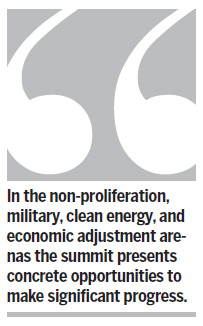View
Hu's visit to readjust US ties
By Kenneth Lieberthal (China Daily)
Updated: 2011-01-17 08:05
 |
Large Medium Small |

President Hu Jintao's state visit to the United States starting from Jan 18 comes 14 months after President Barack Obama's November 2009 visit to China. The intervening period has seen many problems in US-China relations, despite progress on some fronts. President Hu's visit will, therefore, be especially important for recalibrating the tone and direction of US-China ties.
The US-China Joint Statement at the end of Obama's visit for the first time raised explicitly the importance of mutual trust. But since then distrust seems to have grown. Both sides see cause for complaint.
From an American perspective, China's international tone has toughened, it has rapidly increased its capacity for military power projection targeted at US capabilities, and it is pursuing progressively more mercantilist economic policies. In short, China is increasingly looking like a traditional 20th century rising power and seems to be straying from its "peaceful development" trajectory articulated earlier this century.
From a Chinese perspective, the US has engaged in protection of its home market and, especially, has moved in the diplomatic and security arenas to reassert its leadership of Asia and to make things more difficult for China in its relations with its neighbors. Many Chinese believe that the US is a declining power that will do anything to prevent China from catching up.
If these mutual perceptions harden, both sides are in for serious problems. Ironically, in reality both share fundamental strategic goals in global stability and economic growth and in reduction of nontraditional security threats such as climate change, terrorism and pandemics. Their economies are highly mutually interdependent. Both are major players in the Asia-Pacific region. Neither seeks to overturn the international system (which has served both very well). And neither can appreciably harm the other without adversely affecting its own future well-being.
It is in this context that President Hu's state visit assumes such importance. The visit provides an opportunity - probably the last before the 18th National Congress of the Communist Party of China and the US presidential election in 2012 - to articulate clearly and realistically the common interests, principles and aspirations that should guide US-China relations in the coming years.
The two presidents need to reduce differences on handling the core nuclear proliferation challenges of our era, especially the Democratic People's Republic of Korea (DPRK) and Iran, neither Beijing nor Washington wants further development of Iran's or the DPRK's nuclear programs, but we must narrow our differences over how to achieve our shared objectives .
Especially on the DPRK, each should listen more carefully to the other's explanation of how best to influence decision making in Pyongyang. And both sides need to begin to talk more seriously about how to handle potential future instability there.
Frictions on military issues in the Western Pacific have grown. US Defense Secretary Robert Gates' visit to Beijing reflects the renewal of military-to-military ties that began in late 2010. But visits are one thing and serious engagement is another.
The US has long had relatively unfettered naval access to the Western Pacific and will not easily change its mindset about that region. China is building up its power projection capabilities in this region and is challenging some longstanding naval practices there.
We need to have detailed, sustained, in-depth dialogue about the rationales behind development of different weapons systems and to adopt "rules of the road" necessary to avoid dangerous incidents at sea. We should also initiate programs that see our military officers participate for sustained periods in programs in each other's military academies. Presidential support for such efforts can reduce distrust between our militaries in the coming years.
We need to demonstrate that we can cooperate on a win-win basis in major economic efforts that will shape the future. Clean energy cooperation is ideal for this: Our national capabilities are generally complementary. This sector will be of growing importance, and working together the US and China can develop and scale up new technologies more rapidly than either side can accomplish alone.
On both government-to-government and private levels, US-China cooperation on clean energy has expanded rapidly. But both sides can do more, especially in addressing concerns over government regulations, technology transfer rules, tariffs, government procurement, intellectual property rights, and related issues. This could pave the way for large-scale investment in both directions to the benefit of both countries. And developing satisfactory solutions to these tough issues in the green technology sphere could have significant beneficial effects in other sectors.
The US and China both must make deep structural reforms in their domestic economies in the coming five years. Each will do better to the extent that both succeed in this difficult effort. Each side should therefore strengthen efforts to support needed economic changes in the other.
Distrust is reduced by devising realistic ways to advance common goals through explaining fully and candidly each side's perspectives and demonstrating mutual abilities to grasp win-win opportunities. In the non-proliferation, military, clean energy, and economic adjustment arenas the summit presents concrete opportunities to make significant progress.
The media attention to the state visit will also afford both leaders an opportunity to educate their peoples on what is at stake in US-China relations and how each sees its own country's related interests. In both countries, some very worrisome popular images of the other are taking hold. Sober, realistic, forward-looking presidential pronouncements may significantly improve public understanding of the challenges, prospects, and potential for US-China relations in the coming years.
The author is director of the John L. Thornton China Center, and a senior fellow at the Foreign Policy and the Global Economy and Development Programs at the Brookings Institution. He served as senior director for Asia on the National Security Council from 1998 to 2000.